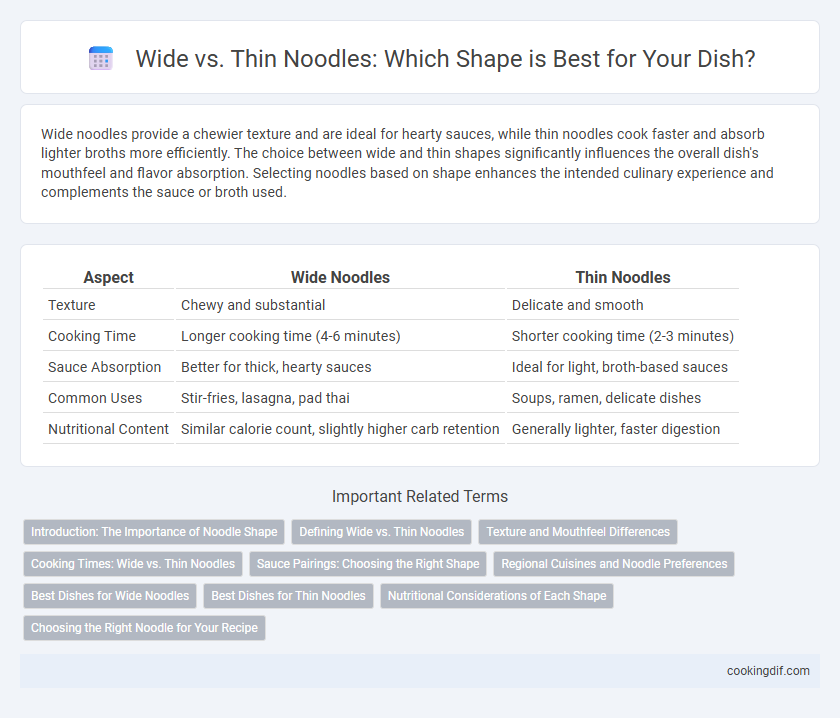Wide noodles provide a chewier texture and are ideal for hearty sauces, while thin noodles cook faster and absorb lighter broths more efficiently. The choice between wide and thin shapes significantly influences the overall dish's mouthfeel and flavor absorption. Selecting noodles based on shape enhances the intended culinary experience and complements the sauce or broth used.
Table of Comparison
| Aspect | Wide Noodles | Thin Noodles |
|---|---|---|
| Texture | Chewy and substantial | Delicate and smooth |
| Cooking Time | Longer cooking time (4-6 minutes) | Shorter cooking time (2-3 minutes) |
| Sauce Absorption | Better for thick, hearty sauces | Ideal for light, broth-based sauces |
| Common Uses | Stir-fries, lasagna, pad thai | Soups, ramen, delicate dishes |
| Nutritional Content | Similar calorie count, slightly higher carb retention | Generally lighter, faster digestion |
Introduction: The Importance of Noodle Shape
Noodle shape significantly influences texture, cooking time, and sauce adherence, making it a crucial factor in culinary applications. Wide noodles like pappardelle offer a tender bite and better absorption of thick sauces, enhancing flavor integration. Thin noodles such as angel hair cook quickly and provide a delicate texture, ideal for light broths and subtle seasonings.
Defining Wide vs. Thin Noodles
Wide noodles, such as pappardelle or fettuccine, are characterized by their broad, flat shape, typically measuring over half an inch in width, offering a substantial texture that holds rich sauces well. Thin noodles, like angel hair or vermicelli, are slender and delicate, usually less than a quarter inch wide, ideal for lighter broths and quick cooking times. The defining factors between wide and thin noodles include width, cooking time, and sauce pairing, influencing the overall dish texture and flavor absorption.
Texture and Mouthfeel Differences
Wide noodles offer a chewy and substantial texture that provides a hearty mouthfeel, enhancing the eating experience with their ability to hold rich sauces. Thin noodles deliver a delicate, smooth texture that glides easily on the palate, creating a lighter and more refined sensation. The choice between wide and thin noodles significantly impacts the overall texture and mouthfeel, influencing dish richness and sauce absorption.
Cooking Times: Wide vs. Thin Noodles
Wide noodles typically require longer cooking times due to their greater surface area and thickness, often taking 5 to 7 minutes to reach the ideal texture. Thin noodles, such as vermicelli or angel hair, cook rapidly, usually within 1 to 3 minutes, making them ideal for quick meals or soups. Adjusting cooking time based on noodle width prevents overcooking and ensures optimal texture and flavor retention in dishes.
Sauce Pairings: Choosing the Right Shape
Wide noodles, such as pappardelle or fettuccine, excel at holding rich, hearty sauces like Bolognese or creamy Alfredo due to their broad surface area that captures thick textures. Thin noodles, including angel hair or vermicelli, suit lighter, oil-based, or broth sauces like garlic and olive oil or clear consommes, allowing flavors to shine without overwhelming the delicate strands. Selecting the optimal noodle shape enhances sauce adherence and balance, elevating the overall dish experience.
Regional Cuisines and Noodle Preferences
Wide noodles like pappardelle are a staple in Tuscan cuisine, offering a broad surface that captures rich, hearty sauces typical of the region. Thin noodles such as vermicelli dominate in Vietnamese pho, where their delicate texture blends seamlessly with the light, aromatic broth. Regional preferences for noodle shape often reflect local ingredients and cooking techniques, with wider noodles favored in robust, slow-simmered dishes and thinner noodles preferred in quick-cooked soups and stir-fries.
Best Dishes for Wide Noodles
Wide noodles excel in dishes like beef stroganoff and pad see ew, where their broad surface holds rich sauces and absorbs bold flavors effectively. Their robust texture provides a satisfying bite, making them ideal for hearty recipes featuring meat, vegetables, and creamy or soy-based sauces. Recipes that leverage wide noodles enhance flavor delivery and create a balanced, comforting meal experience.
Best Dishes for Thin Noodles
Thin noodles excel in light, broth-based dishes like Pho, Ramen, and Vietnamese Bun, where their delicate texture enhances the soup's flavor without overpowering it. They absorb sauces quickly, making them ideal for stir-fries such as Pad Thai or Chinese Chow Mein, providing a smooth, silky mouthfeel. Compared to wide noodles, thin varieties offer greater versatility in dishes requiring quick cooking and subtle sauce integration.
Nutritional Considerations of Each Shape
Wide noodles often have a larger surface area, which can lead to higher carbohydrate intake per serving compared to thin noodles. Thin noodles tend to cook faster and may have a slightly lower glycemic index, potentially benefiting blood sugar control. Both shapes vary little in protein or fiber content, so portion size and cooking methods primarily influence their nutritional impact.
Choosing the Right Noodle for Your Recipe
Wide noodles offer a hearty texture and are ideal for rich, thick sauces that cling to their broad surface, enhancing flavor intensity in recipes like beef stroganoff or lasagna. Thin noodles cook quickly and absorb lighter broths or delicate sauces, making them perfect for dishes such as ramen or angel hair pasta with olive oil and garlic. Selecting the right noodle shape depends on the sauce consistency and desired mouthfeel, ensuring a balanced and complementary dish.
Wide vs thin for noodle shape Infographic

 cookingdif.com
cookingdif.com